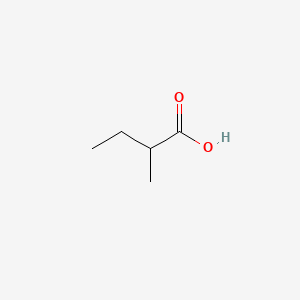| MeSH term | MeSH ID | Detail |
|---|---|---|
| Adenocarcinoma | D000230 | 166 associated lipids |
2-Methylbutanoic acid
2-Methylbutanoic acid is a lipid of Fatty Acyls (FA) class. The involved functions are known as Binding (Molecular Function), Oxidation, isoleucine catabolic process, Anabolism and physiological aspects. 2-methylbutanoic acid often locates in Membrane, soluble and host. The associated genes with 2-Methylbutanoic acid are Homologous Gene, Genome, NKS1 gene, HM13 gene and ACSM1 gene. The related lipids are Fatty Acids, Butyric Acids, branched chain fatty acid, Propionate and 2-methylvalerate.
Cross Reference
Introduction
To understand associated biological information of 2-Methylbutanoic acid, we collected biological information of abnormalities, associated pathways, cellular/molecular locations, biological functions, related genes/proteins, lipids and common seen animal/experimental models with organized paragraphs from literatures.
What diseases are associated with 2-Methylbutanoic acid?
There are no associated biomedical information in the current reference collection.
Possible diseases from mapped MeSH terms on references
We collected disease MeSH terms mapped to the references associated with 2-Methylbutanoic acid
PubChem Associated disorders and diseases
What pathways are associated with 2-Methylbutanoic acid
There are no associated biomedical information in the current reference collection.
PubChem Biomolecular Interactions and Pathways
Link to PubChem Biomolecular Interactions and PathwaysWhat cellular locations are associated with 2-Methylbutanoic acid?
Visualization in cellular structure
Associated locations are in red color. Not associated locations are in black.
Related references are published most in these journals:
| Location | Cross reference | Weighted score | Related literatures |
|---|
What functions are associated with 2-Methylbutanoic acid?
Related references are published most in these journals:
| Function | Cross reference | Weighted score | Related literatures |
|---|
What lipids are associated with 2-Methylbutanoic acid?
Related references are published most in these journals:
| Lipid concept | Cross reference | Weighted score | Related literatures |
|---|
What genes are associated with 2-Methylbutanoic acid?
Related references are published most in these journals:
| Gene | Cross reference | Weighted score | Related literatures |
|---|
What common seen animal models are associated with 2-Methylbutanoic acid?
There are no associated biomedical information in the current reference collection.
NCBI Entrez Crosslinks
All references with 2-Methylbutanoic acid
Download all related citations| Authors | Title | Published | Journal | PubMed Link |
|---|---|---|---|---|
| Komuniecki PR and Vanover L | Biochemical changes during the aerobic-anaerobic transition in Ascaris suum larvae. | 1987 | Mol. Biochem. Parasitol. | pmid:3033496 |
| Xiao ZB et al. | Comparison of volatile components in Chinese traditional pickled peppers using HS-SPME-GC-MS, GC-O and multivariate analysis. | 2010 | Nat. Prod. Res. | pmid:21108121 |
| Orav A et al. | Essential oil composition of Pimpinella anisum L. fruits from various European countries. | 2008 | Nat. Prod. Res. | pmid:18266152 |
| Kobayakawa K et al. | Innate versus learned odour processing in the mouse olfactory bulb. | 2007 | Nature | pmid:17989651 |
| Kenakin TP and Beek D | The effects on Schild regressions of antagonist removal from the receptor compartment by a saturable process. | 1987 | Naunyn Schmiedebergs Arch. Pharmacol. | pmid:3561525 |
| MurÃn R et al. | Glial metabolism of isoleucine. | 2009 | Neurochem. Res. | pmid:18787950 |
| Westermann CM et al. | Acquired multiple Acyl-CoA dehydrogenase deficiency in 10 horses with atypical myopathy. | 2008 | Neuromuscul. Disord. | pmid:18406615 |
| Sung K et al. | Possible effects of nitric oxide synthases on odor-induced behavioral changes in mice. | 2014 | Neurosci. Lett. | pmid:24747686 |
| Queenan KM et al. | Concentrated oat beta-glucan, a fermentable fiber, lowers serum cholesterol in hypercholesterolemic adults in a randomized controlled trial. | 2007 | Nutr J | pmid:17386092 |
| Kølvraa S et al. | Studies of the glycine metabolism in a patient with D-glyceric acidemia and hyperglycinemia. | 1980 | Pediatr. Res. | pmid:7454444 |
